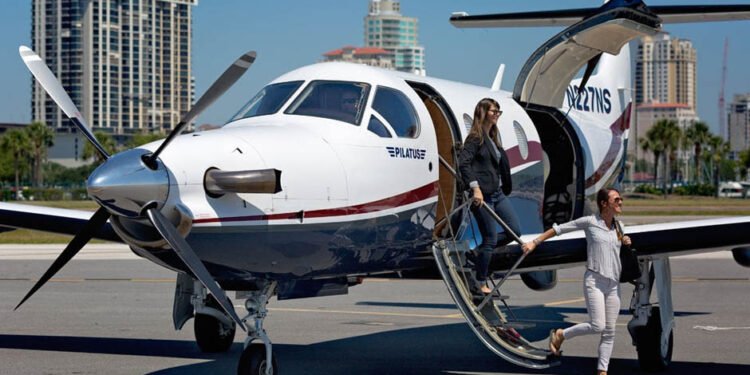Thinking of chartering your plane? Whether you’re an aircraft owner looking for a new revenue stream or just exploring your options, the idea of turning your private plane into a profit-generating asset is an exciting one. But where do you start, and what should you keep in mind along the way? Let’s break it down into the essentials, so you can make informed decisions and avoid any turbulence.
Why Chartering Can Be Lucrative
Owning an aircraft comes with significant expenses. Maintenance, storage, insurance, and other costs can add up quickly. Chartering provides a way to offset these expenses while keeping your plane in active use. Beyond that, it offers:
- Revenue Potential – Depending on the type and size of your aircraft, chartering could bring in thousands of dollars per flight.
- Efficient Use – Planes thrive when used regularly. Idle aircraft are more prone to maintenance issues, so keeping your plane in operation can actually lower costs in the long term.
- Growing Demand – Private charters have surged in popularity. Business professionals, leisure travelers, and even last-minute cargo needs are fueling a booming market.
That said, success doesn’t come automatically. It takes planning, smart choices, and a clear understanding of the market.
Legal and Regulatory Considerations
Before you start flying charter clients, you’ll need to ensure your operation meets all legal and regulatory requirements. This is not a “set it and forget it” process, as the aviation industry is highly regulated. Here are the key areas to focus on:
- Air Operator Certification – Most countries require a specific certificate to legally operate charter flights. In the U.S., for example, you’ll need a Part 135 certification.
- Insurance Coverage – Standard aircraft insurance isn’t enough for charter operations. You’ll need commercial liability insurance to cover passengers and operations.
- Maintenance and Inspection – Regular maintenance is critical for safety and compliance. Aircraft used for charter services often require more frequent inspections.
- Crew Requirements – Pilots and crew need appropriate licensing and training to operate charter flights. They’ll also need to meet the hours and experience requirements set by aviation authorities.
Getting these ducks in a row may take time, but it’s non-negotiable for running a safe and legal operation.
Partnering with the Right Support
If you’re serious about chartering, having the right support makes all the difference. That might mean partnering with a management company, broker, or distributor to keep things running smoothly. Pilot John International, for instance, supports aviation operations worldwide by distributing and servicing top-tier equipment. Collaborating with experts like these can streamline your setup, helping you focus on growing your charter business without getting bogged down in technical challenges.
Setting Competitive Pricing
Pricing your charter services isn’t as simple as picking a number. It requires balancing what the market can bear with your own operating costs. Consider these factors when determining your rates:
- Aircraft Type – Larger jets command higher prices but also come with steeper operating costs.
- Market Trends – Research what competitors in your area are charging for similar aircraft and routes.
- Operating Expenses – Don’t forget to factor in fuel, crew salaries, and maintenance.
- Passenger Experience – Luxuries like onboard Wi-Fi, catering, and entertainment can justify premium pricing.
- Flexibility – Some clients value last-minute availability or customized itineraries and will pay a premium for these services.
Regularly reviewing your pricing structure ensures you stay competitive while maximizing your profit margins.
Building Trust and Attracting Clients
Reputation is everything in the charter industry. To attract and retain clients, you’ll need to build trust through reliable service and consistent communication. Here’s how:
- Safety First – Passengers need to feel secure. Make sure your safety protocols are clearly communicated and always upheld.
- Transparency – Clients appreciate upfront pricing with no hidden fees. Surprise costs can hurt your reputation.
- Personalized Service – Small touches, like remembering a passenger’s preferences, can create loyal customers.
- Marketing Efforts – Don’t overlook the power of a strong online presence. Invest in a professional website and make use of social media to showcase your aircraft and services.
- Partner Referrals – Brokers and travel agencies can connect you to high-value clients, so building relationships in the industry is worth your time.
By consistently delivering exceptional service, you’ll establish your plane as a go-to choice for charters.
Reducing Costs Without Cutting Corners
Profit margins in the charter business are heavily influenced by your ability to manage expenses. Here are five ways to keep costs under control:
- Fuel Efficiency – Use flight planning tools to optimize routes and reduce fuel consumption.
- Smart Scheduling – Consolidate flights when possible to minimize downtime and unnecessary repositioning costs.
- Proactive Maintenance – Staying ahead of maintenance needs prevents costly repairs down the line.
- Group Insurance Rates – Explore insurance options through group plans to lower premiums.
- Leverage Technology – From booking platforms to fleet management software, digital tools can improve efficiency and reduce overhead.
The key is cutting costs in ways that don’t compromise safety or passenger experience.
Planning for Long-Term Success
Chartering a plane isn’t just about immediate revenue; it’s about building a sustainable business. Here are a few things to consider as you plan for the future:
- Expand Your Fleet – If demand grows, adding another aircraft can increase your revenue potential.
- Understand Seasonal Demand – Travel trends can fluctuate, so plan for peak and low seasons accordingly.
- Continuous Learning – Stay updated on industry trends, regulatory changes, and customer preferences to keep your edge.
- Invest in Staff – Experienced pilots and friendly crew members are assets worth retaining.
- Be Open to Feedback – Listening to clients’ experiences can help refine your services.
Thinking long-term ensures your charter operation remains profitable and competitive.
Flying Towards Profitability
Turning your aircraft into a charter business can be a rewarding endeavour, both financially and personally. By taking the time to navigate regulations, price competitively, and deliver excellent service, you can turn your plane into a profitable and sought-after asset. With the right planning and execution, you’ll not only offset ownership costs but also create new opportunities for growth. So, what’s your next move? The sky’s the limit.












